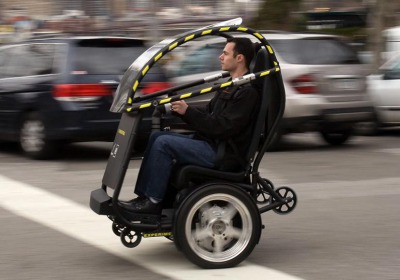General Motors reveals two-wheel PUMA electric-vehicle prototype
Mon, 06 Apr 2009
It’s based on the same driving principles as a skateboard. It looks like a phone booth, or perhaps a baby stroller. But despite the unconventional nature of this vehicle, General Motors says a two-seat, two-wheel ride called PUMA could be a solution to loosen congestion in crowded urban areas.
The acronym stands for Personal Urban Mobility and Accessibility, and on Tuesday GM is announcing a partnership with small vehicle company Segway to develop the diminutive rides. A prototype is also expected to be demonstrated in New York.
PUMA vehicles employ existing technologies, including a lithium-ion battery, dual electric wheel motors and connectivity with other vehicles and infrastructure. They can travel at speeds of 35 mph and have a range of 35 miles between charges. In addition to big cities, they could be used in parks, college campuses, amusement parks, resorts and other areas where short distances are usually traveled.
GM says the prototype in New York is operational, and expects a next-generation model to appear later this year. In early 2010, a complete concept could be unveiled. The rides look like golf carts, though executives say catchy design could be part of a production version if the project continues.
It’s based on the premise that many cars are “over-engineered” for some driving situations. A Cadillac Escalade, for example, is probably unnecessary to drive a few blocks in Manhattan, where research says the average speed was 18.8 miles per hour and three-quarters of the population doesn’t own a car, according to research cited by GM, which has been working with Segway for about 18 months on the project.
“It’s not replacing vehicles as we know them--it’s complementing them in an urban environment,” said Chris Borroni-Bird, director of advance technology vehicle concepts for GM.
The PUMAs would be a tradeoff in features--the two passengers sit snugly side-by-side, but could prove to be a money saver. The cost could be one-quarter to one-third of owning a conventional midsize vehicle, GM says. Because they’re small, ease of parking would also be a key selling point, as up to 30-40 percent of fuel is believed to be consumed looking for parking in urban areas.
Still, the project is a bit fanciful, as GM envisions a potential layout where cars interact using an onboard transponder and can brake and accelerate through intersections to avoid accidents and pedestrians. Though GM based much of its research on New York City, the PUMA vehicles could launch overseas first. Domestically, the program could help bolster the automaker’s green credentials.
“The [auto] Task Force is looking for us to show a vision of the future, and I think this could be a part of it,” Borroni-Bird said.
By Greg Migliore

